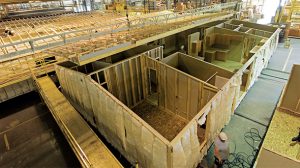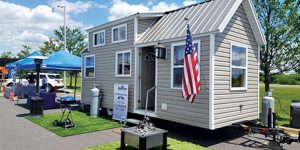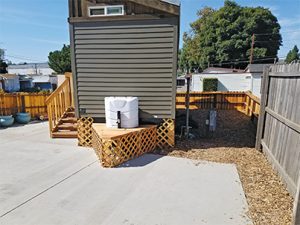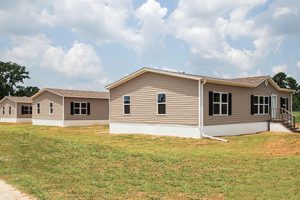Propane’s role in the reemergence of manufactured homes

Factory-built housing presents propane providers with opportunities for meeting a family’s utility needs after the structure is placed and the family settles into their new home. Photo courtesy of Clayton Homes
Factory-built housing presents propane providers with opportunities for meeting a family’s utility needs after the structure is placed and the family settles into their new home.
Depending on your local circumstances, several avenues are available for tapping into this market by connecting with manufacturers, dealers, on-site installation contractors and builders, as well as multi-unit superintendents and the new residents themselves.
According to Todd Miller at White Mountain Oil & Propane in North Conway, New Hampshire, when taking a proactive sales approach, you find an opportunity to place your steel in the ground and get a leg up on competing energy sources.
Miller notes the importance of relationships with area contractors and suggests getting involved with a contractor’s or builder’s association in your area to pitch propane’s value.
“An awful lot of homeowners are going to go with what the contractor recommends, and once the homeowner makes the decision to select propane it opens up a whole new world to them,” Miller says.
Appliances such as ranges and ovens, water heaters, clothes dryers, furnaces, fireplace inserts, patio fire pits and generators can all be powered by propane. Miller notes propane can even be used to heat swimming pools.
According to Steve Southward, CEO of Cleveland Petroleum Products in Tulsa, Oklahoma, if done right, a propane company can have a significant portion of the manufactured home market. About 20 percent of the company’s residential propane sales are directed to some type of manufactured home household.
The company also serves mobile home parks where propane is the only fuel source available and it supplies propane to other rolled-into-place structures or more-permanent modular homes. The company typically deals with the end user when making a sale, and propane is especially appealing in locales where electrical outages are common.
“Electricity is not as reliable as propane,” Southward says. “The customers who have been around here know what we can offer, making propane a most-suitable solution during the utility-selection process.”
Though there has been an overall decline in demand for these types of housing units, particularly as they pertain to propane – a scenario further impacted by the encroachment of the heat pump – Southward remains optimistic.
“We still have a significant portion of the market out there, and our future feels bright,” he says.
But challenges remain. If a unit is cramped for space or cost is an issue, a single heat pump can handle winter heating and summer cooling alike.
“It became unacceptable not to have air conditioning, and as the heat pump technology changed it became only one piece of equipment to serve both roles,” notes industry analyst Michael Sloan, principal at ICF. “For many new homeowners, it’s easier to have an electrical hookup rather than natural gas or propane. It’s a challenging market.”
Know your homes
An assortment of structural styles is included in the overall manufactured and modular home category.
The Department of Housing and Urban Development defines precise standards, but generally speaking a modular home is hauled to the site on a flatbed truck in prefabricated sections called modules and positioned via crane upon a foundation meant to remain intact for the foreseeable future.
A manufactured home is a factory-constructed structure – representing varying degrees of size, quality, economy and luxury – that uses wheels in the placement process. A foundation can consist of cinder blocks, jacks and sheets of lattice, or can be left mostly open.
Recreational vehicles and campers are propane friendly and can be parked in a park or an in-law’s backyard, but they are typically not viewed as official residential housing units.
Tiny houses are picking up in popularity, and while these stand-alone, towed-in structures might be a bit snug on space they can go well beyond anyone’s notion of lower-end accommodations, often comparable in quality to higher-end stick-built homes.
Declining market share
As of 2015, there were about 840,000 manufactured homes in the U.S. using propane for space heating, amounting to a 13 percent market share within the segment and 14 percent of the total propane-heated housing stock, down from 21 percent in 2000, according to Sloan.

Blossman Gas uses a propane-powered tiny house to attract homebuyers and manufacturers. Photo courtesy of Blossman Gas
“Propane had a major share of the market – 45 percent to 50 percent – through the 1990s,” he says.
Since 2000, shipments of manufactured housing have declined in total by 72 percent and propane’s portion has fallen by 90 percent.
Financing rates have risen relative to regular housing, and people want nicer places to live, Sloan says. He is also quick to point out that manufactured homebuilders are making the homes look nicer, helping them gain market share, though end-user costs are more expensive.
While shipments may be experiencing some modest increases, they remain well below previous levels.
“The number of total manufactured households and propane-heated manufactured households has declined year-over-year for the past decade. This trend is expected to continue through 2025,” Sloan says.
Despite these daunting figures, pockets of propane demand remain. According to Josh McAdams, vice president of McAdams Propane Co., some people buy a plot of land on which to place a manufactured home. In East Texas, where McAdams Propane operates, the sector generates 5 to 10 percent of the company’s load.
Steven Lefler, vice president of Modular Lifestyles in Irvine, California, observes that expanses of the state’s permanent housing stock have been diminished from San Diego to Napa, California, due to wildfires and mudslides, making manufactured housing a promising replenishment option.
These homes give individuals the opportunity to move back and live on their property, he says. They can hook up with propane for generators and tankless water heaters in recovering neighborhoods still lacking electrical and natural gas service.
“We can deliver a home to you in a day. Just clear out the area, connect the water and sewer, and you can live in a house tomorrow,” Lefler explains. “You can live in a house on your own property rather than living in a friend’s back bedroom or in an RV.”
The company’s 400-sq.-ft. Quest model can be placed in a backyard or on almost any piece of vacant land and includes a propane-fueled furnace, two-burner stove, tankless water heater and electrical generator. These homes are especially well suited for aging individuals living on a fixed income.
“Every day for the next 20 years, 10,000 baby boomers will turn 65,” Lefler says. “These portable homes could have major implications for families who can’t afford an assisted living facility.”
Off-grid living
One trend not to be overlooked is the living-off-the-grid movement, which now includes urban pioneers moving entire homes onto previously distressed inner-city properties.
Off-gridder participants also include rural settlers or millennials with limited disposable income. Others, however, are higher-earning adventurers embracing the concept of tiny houses, also known as micro housing.
“They’re certainly getting some press and some buzz,” Sloan says. “And it would be logical to put propane heat in them.”
Cities are warming to the idea of micro housing and adjusting zoning and building codes accordingly, says Randy Doyle, CFO of Blossman Gas.

Manufactured houses can be placed on almost any piece of vacant land and burn propane-fueled appliances. photo courtesy of modular lifestyles
Spanning the economic and price-point spectrum, single-person households are increasing; corporations are utilizing these units to alleviate worker housing shortages; and immigrants from densely-populated countries consider them to be a comfortable alternative to steeper rental rates.
Reclaiming the category
Intent on increasing propane’s presence within the manufactured and modular home marketplace, Blossman Gas and other retailers have been working with the Propane Education & Research Council (PERC) to explore initiative, such as attending construction industry trade shows.
According to Doyle, this mission will be ongoing for several years. Propane used to dominate the market and the industry has to work to get it back, he says.
“The manufactured home market is something people have been talking about going back several years – and how it’s been slipping away – and we want to get it back,” he notes. “We’re putting some legs under it. If a marketer wanted to move into this space, what would we do? That’s what we’re trying to get our arms around.”
It’s also important to reach the manufacturer and the homebuyer, notes Scott Pruitt, a regional vice president at Blossman Gas. Both the builder and the buyer should be informed of how propane can help fuel the home’s appliances.

Highlighting the features and benefits of propane appliances can aid marketers in specifying propane in manufactured and modular homes. Photo Courtesy of clayton homes
“We often find the homebuyer by exhibiting a custom propane-powered tiny house at home shows,” he notes. “We also want to make sure the manufacturers know what we have to offer so that installation of the appliances are economical and efficient. Being propane driven helps people obtain the off-grid or vacation lifestyle they’re looking for, which is why it’s so important for us to reach the homebuilder.”
These units frequently come equipped with electrical appliances already installed on the factory floor, so it is likely to deliver significant results by connecting with executives at the manufacturer level to promote propane-powered tankless water heaters and other appliances.
“In a manufactured house, space is always an issue, and tankless water heaters take up less space,” Doyle says.
According to Jesse Marcus, director of residential and commercial business development at PERC, by highlighting the features and benefits of propane appliances, marketers can aid in specifying propane in new and existing manufactured and modular homes.
“Those benefits include increased comfort and efficiency, and lowered emissions and cost,” Marcus says. “Propane is an excellent energy source no matter what type of home they live in. Also, propane is reliable, dependable and produced domestically.”
PERC offers training courses and a variety of appropriate advice at propanetrainingacademy.com and buildwithpropane.com, contrasting propane’s features and benefits with electricity, heating oil and geothermal.
These resources are relevant to all homes where space heating, water heating, cooking, clothes drying and fireplace applications are prevalent, Marcus says. Manufactured or modular homebuilders are good targets because they can promote propane options in their catalogs or on their showroom floors.
“The builder likes propane as an option because they can often sell the home at a higher premium due to the progressive and advanced technology,” Marcus says. “Making the homeowner aware of propane’s benefits is also critical, as they have the ability to customize their home, meaning selecting the types of appliances and energy source installed in their home. The more a propane marketer can educate the manufacturer, builder and homeowner, the better.”
















